On December 16, 2017, the co-founders of the 9/11 Consensus Panel, authors Dr. David Ray Griffin and Elizabeth Woodworth, issued a challenge to the 9/11 research community regarding disputed evidence about the events at the Pentagon. They noted that "unfortunately, there are areas of disagreement, especially with regard to the Pentagon, that threaten to undermine good will and mutual trust." They then continued setting the background for a challenge by stating, "... odd phenomena and anomalies continue to cause speculation and disagreement. Some scholars can justifiably take one set of data as most important, while playing down the importance of another set, while other scholars can justifiably take the second set of data as most important. These differences of opinion can be justifiable until there is a theory that can take account of all the indisputable evidence."
With this as the background, the 9/11 Consensus Panel then issued a challenge by saying, "Contributions seeking to solve contentious issues can only be made by assembling reliable evidence and by applying critical thinking and peer review according to the standard scientific process. This is the strength of science and the way it has progressed over centuries. In conclusion, we offer the 'agree to differ' approach: to end an argument amicably while maintaining differences of opinion until there is an explanation that does justice to all the various types of evidence."
In an answer to the challenge, a five-and-a-half-hour lecture consisting of over 900 slides, detailing the physical damage to the Pentagon and the environs, was submitted. As shown in the lecture, the results of combing through the evidence shows, unequivocally, that the damage at the Pentagon was done by a large plane impact that would be consistent with a Boeing 757. The lecture focuses on the issue of what mechanism caused the damage to the Pentagon on 9/11. With this as the focus, pertinent background information is reviewed to provide context about the controversy and how this challenge arose.
The purpose of this lecture is to assemble as much of the information that is known about the Pentagon damage into a single presentation that includes not only the well-trodden evidence for a large plane impact, but also new information that has been uncovered.
Highlights of new points of information that are introduced and explained in this lecture are:
1) A large piece of debris that has been commented upon since the early days of the 9/11 Pentagon research -- but whose context was unknown -- has been identified and located. The newly identified piece is a leading wing slat, consistent with those installed on the front of the wing of a Boeing 757. Its location was documented to be between light pole #3 and the impact point at the Pentagon facade. This is along the approach path where wing debris, subject to a damaging impact with light poles, would be expected to have been found.
2) A tree located in front of column 16 was severed and the lower trunk was observed kicked to the north approximately 100 feet. The top branches of this tree were photographed burning at the north end of the impact area and they were the subject of confusion, with some arguing that these branches were steel rebar (e.g., remnants of columns that were exploded outward). The lower tree trunk was seen during the fire and was photographed later, after it had been "limbed" during the early clean-up activities. The severing of this tree can only be explained by a large-momentum impact -- one that would be consistent with a Boeing 757.
3) Column 19 on the second floor is bashed in approximately 18" above the second-floor slab. This is consistent with an impact by the right wing, which would have been angled upward and crossed the second floor slab at, or just to the right of, column 18. Column 18 was not only bashed in, it was photographed leaning southward, which is the direction that would be expected if the column was the fulcrum where the right wing pivoted and "muscled-its-way-into" the interior of the building. This is another point of evidence that researchers advocating for the hypothesis of a large plane impact have not documented.
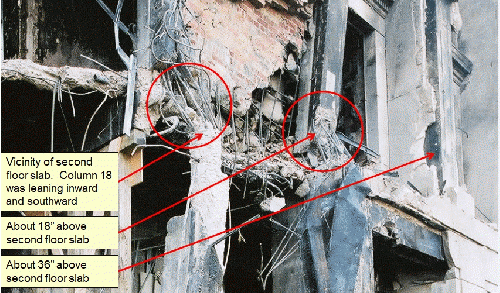
Exterior columns 18 and 19, at and above the second floor slab, have been bases in and column 19 has been pushed away from the impact area consistent with it having been the fulcrum for the pivoting right wing.
(Image by Jocelyn_Augustino (FEMA, #4969, Sept. 21, 2001, annotations added)) Details DMCA
4) There were no sections of reinforced-concrete walls in the path through the Pentagon from the E-Ring entrance point to the C-Ring exit hole. The only steel-reinforced concrete in the path of the impacting plane was the 1942-era 21"x21" columns. These columns provided limited resistance to the impact, which is well documented in the form of bent and bowed columns. The outer E-Ring wall consisted of steel window frames supporting "blast-resistant" windows. These window frames were attached to the Pentagon structure using only a dozen 3/4-inch bolts per window segment.
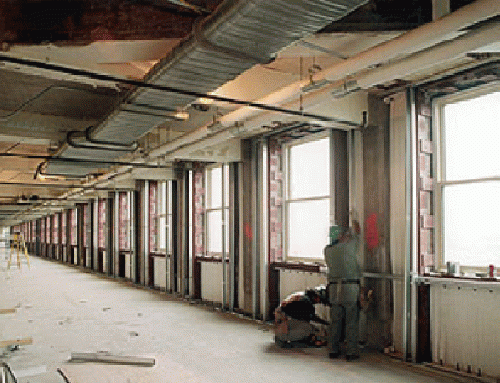
The outer E-Ring wall was built with a steel tube frame supporting a 1,600 lb window frames that was bolted in place. There was no reinforced concrete.
(Image by Pentagon Renovation Program, US Department of Defense, September 2000) Details DMCA
5) Analysis shows that there were three paths through the columns from the E-Ring entrance point to the C-Ring exit hole. These paths are estimated to be at least 2.5 feet, 2.3 feet and 1.1 feet wide. This is another point of evidence that researchers describing a large-plane impact have not documented. Instead, explanations evolved of "slurries" zooming in-and-around columns. These explanations did not add credibility to their arguments. These three paths are sufficient for heavy parts of the aircraft to travel, unimpeded, through the rows of columns.
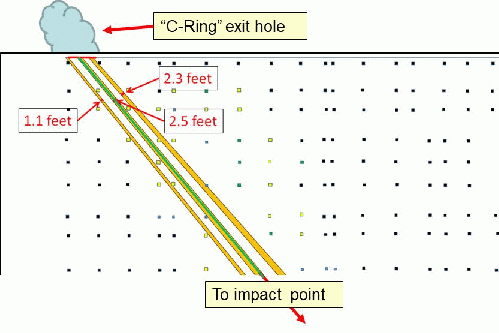
Three paths allowed heavy debris from the aircraft to travel, unimpeded, through the rows of columns on the first floor.
(Image by Wayne Coste, PE) Details DMCA
6) The C-Ring exit hole was in a unreinforced wall in the un-refurbished Wedge 2. The hole was located in a 19-foot-wide x 10-foot-high section of wall that was only two bricks thick, with no visible reinforcing. A wall constructed in this manner could easily be knocked-down by the heavy, high-velocity parts seen in the outside debris, that traveled through one of the three paths through the columns.
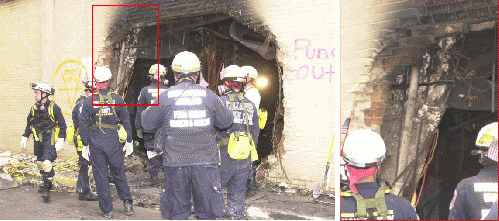
The C-Ring exit hole was located in a 19 foot wide x 10 foot high section of wall that was only two bricks thick, with no visible reinforcing.
(Image by Jocelyn_Augustino (FEMA, #4515, Sept. 14, 2001, annotations added)) Details DMCA
7) An analysis of the two parking-gate security cameras shows a remarkable amount of information. In fact, there is enough information to estimate that the impacting aircraft was approaching the Pentagon at 542 mph (+/- measurement error). This is based on an analysis that shows the timing difference between the cameras is 4/30th of a second (the cameras were known to record in increments of 1/30th of a second). A review of Mickey Bell's truck traveling across the lawn immediately after the impact validates (or establishes) this timing interval. No other analyses about the security cameras at the Pentagon have ever commented upon Mickey Bell's truck and what it says about the times between these recordings.
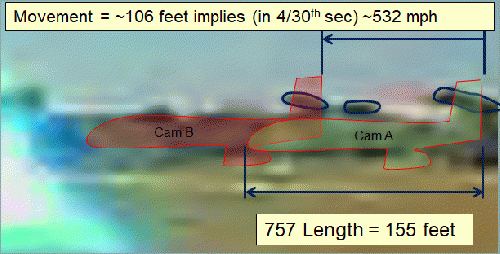
Aligning the two parking gate security cameras allows the two images of the plane to be located. The superimposed envelopes show a movement between the two cameras 'snaps' to be about 106 feet.
(Image by US Department of Defense (September 2000, annotations added)) Details DMCA
8) The sound of an "explosion" recorded by Audrey Barnes of Fox 5 news at 10:10 and 3 seconds was documented to be a sonic boom. This was established by another contemporary broadcast, where it was reported seconds later by Frank Herzog of CBS-9 that the same "boom" was heard at the Washington Mall as planes were flying overhead. The time of this "boom" would be consistent with the end of the Porter Goss interview outside the US Capitol where a "boom" was also recorded. Pentagon researchers have never documented the contemporaneous nature of these three linked events.
After nearly four years of studying the evidence at the Pentagon on 9/11, it has become obvious that advocates for a large-plane impact have done inadequate research and documentation of the evidence. This poor research has resulted in a lost decade and a half for those of us seeking justice for the crimes of 9/11.
This lecture answers the 9/11 Consensus Panel challenge by providing "an explanation that does justice to all the various types of evidence."




